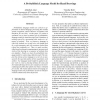Free Online Productivity Tools
i2Speak
i2Symbol
i2OCR
iTex2Img
iWeb2Print
iWeb2Shot
i2Type
iPdf2Split
iPdf2Merge
i2Bopomofo
i2Arabic
i2Style
i2Image
i2PDF
iLatex2Rtf
Sci2ools
ICPR
2010
IEEE
2010
IEEE
A Probabilistic Language Model for Hand Drawings
Probabilistic language models are critical to applications in natural language processing that include speech recognition, optical character recognition, and interfaces for text entry. In this paper, we present a systematic way to learn a similar type of probabilistic language model for hand drawings from a database of existing artwork by representing each stroke as a sequence of symbols. First, we propose a language in which the symbols are circular arcs with length fixed by a scale parameter and with curvature chosen from a fixed low-cardinality set. Then, we apply an algorithm based on dynamic programming to represent each stroke of the drawing as a sequence of symbols from our alphabet. Finally, we learn the probabilistic language model by constructing a Markov model. We compute the entropy of our language in a test set as measured by the expected number of bits required for each symbol. Our language model might be applied in future work to create a drawing interface for noisy a...
| Added | 07 Dec 2010 |
| Updated | 07 Dec 2010 |
| Type | Conference |
| Year | 2010 |
| Where | ICPR |
| Authors | Abdullah Akce, Timothy Bretl |
Comments (0)

